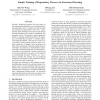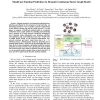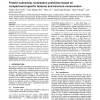78 search results - page 3 / 16 » Structured Prediction Models via the Matrix-Tree Theorem |
IJCAI
2007
13 years 6 months ago
2007
Recently, significant progress has been made on learning structured predictors via coordinated training algorithms such as conditional random fields and maximum margin Markov ne...
CSB
2003
IEEE
13 years 10 months ago
2003
IEEE
Recognition of a protein’s fold provides valuable information about its function. While many sequence-based homology prediction methods exist, an important challenge remains: tw...
BMCBI
2008
13 years 5 months ago
2008
Background: With the abundant information produced by microarray technology, various approaches have been proposed to infer transcriptional regulatory networks. However, few appro...
ICDM
2010
IEEE
13 years 3 months ago
2010
IEEE
Human emotion is one important underlying force affecting and affected by the dynamics of social networks. An interesting question is "can we predict a person's mood base...
BMCBI
2007
13 years 5 months ago
2007
Motivation: Protein subcellular localization is crucial for genome annotation, protein function prediction, and drug discovery. However, since determining subcellular localization...



